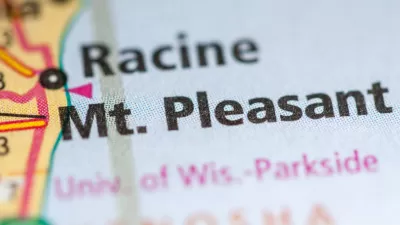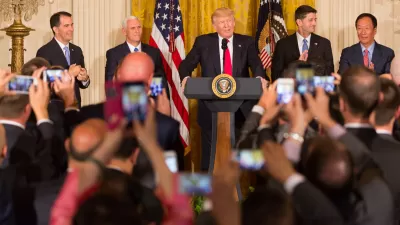Wisconsin taxpayer will be paying the bill for the deal to bring Foxconn to Racine "for decades, if not generations, to come."

Bruce Murphy devotes feature-length attention to the evolution of the deal that brought a massive Foxconn manufacturing plant to Racine County, in southeastern Wisconsin.
The original deal, written on the back of a napkin, offered Foxconn $3.1 billion, "far and away the largest in Wisconsin history and the largest government handout to a foreign company ever given in America," writes Murphy. Since the deal was announced in July 2017, that subsidy has ballooned to $4.1 billion.
But what seemed so simple on a napkin has turned out to be far more complicated and messy in real life. As the size of the subsidy has steadily increased to a jaw-dropping $4.1 billion, Foxconn has repeatedly changed what it plans to do, raising doubts about the number of jobs it will create. Instead of the promised Generation 10.5 plant, Foxconn now says it will build a much smaller Gen 6 plant, which would require one-third of the promised investment, although the company insists it will eventually hit the $10 billion investment target. And instead of a factory of workers building panels for 75-inch TVs, Foxconn executives now say the goal is to build “ecosystem” of buzzwords called “AI 8K+5G” with most of the manufacturing done by robots.
The article documents that growing size the subsidies offered in the deal, as well as the contraction of the new facility promised in return for the subsidies. That's only part of the story, however, as concerns grow about the environmental externalities of the future Foxconn plant. Wisconsin has exempted Foxconn from the state's environmental rules, "allowing it to discharge materials into wetlands and reroute streams during construction and operation" and also "[exempting] the company from doing an Environmental Impact Statement." Lee Bergquist reported in March that the plant "would rank among the highest in southeastern Wisconsin for pollutants that create smog, also known as ozone pollution."
All of the debate and concern over the size of the state's subsidy to Foxconn, and the reality of what it might get in return, is in context of the impending gubernatorial election, in which Gov. Scott Walker is seeking a third term in office.
FULL STORY: WISCONSIN’S $4.1 BILLION FOXCONN BOONDOGGLE

Maui's Vacation Rental Debate Turns Ugly
Verbal attacks, misinformation campaigns and fistfights plague a high-stakes debate to convert thousands of vacation rentals into long-term housing.

Planetizen Federal Action Tracker
A weekly monitor of how Trump’s orders and actions are impacting planners and planning in America.

San Francisco Suspends Traffic Calming Amidst Record Deaths
Citing “a challenging fiscal landscape,” the city will cease the program on the heels of 42 traffic deaths, including 24 pedestrians.

Defunct Pittsburgh Power Plant to Become Residential Tower
A decommissioned steam heat plant will be redeveloped into almost 100 affordable housing units.

Trump Prompts Restructuring of Transportation Research Board in “Unprecedented Overreach”
The TRB has eliminated more than half of its committees including those focused on climate, equity, and cities.

Amtrak Rolls Out New Orleans to Alabama “Mardi Gras” Train
The new service will operate morning and evening departures between Mobile and New Orleans.
Urban Design for Planners 1: Software Tools
This six-course series explores essential urban design concepts using open source software and equips planners with the tools they need to participate fully in the urban design process.
Planning for Universal Design
Learn the tools for implementing Universal Design in planning regulations.
Heyer Gruel & Associates PA
JM Goldson LLC
Custer County Colorado
City of Camden Redevelopment Agency
City of Astoria
Transportation Research & Education Center (TREC) at Portland State University
Jefferson Parish Government
Camden Redevelopment Agency
City of Claremont




























